Interview by Alison Hugill in Berlin // Thursday, Mar. 03, 2016
Open Forum is a domestic project space owned by gallerists Nick Königsknecht and Hannes Schroeder-Finckh. The couple have opened their home to show work by admired emerging artists, blurring the boundaries between collector, audience and exhibitor. Last year they invited curators Carson Chan and Clara Meister to invent a show that reflected this plasticity of roles. The group show Home Work has been going on for over a year, with a heterogeneous mix of performative pieces, many of which only the pair are able to witness first-hand.
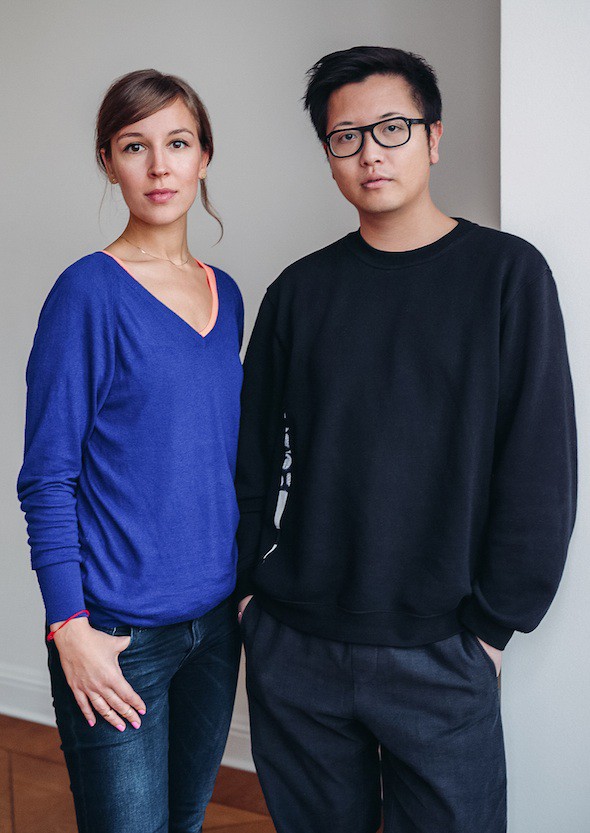
Clara Meister and Carson Chan // Photo by Trevor Good
One exception is Louis-Philippe Scoufaras‘ piece, in which he has given the public control over a table lamp situated in Koenigsknecht and Schroeder-Finckh’s living area. Through the website www.lightpressure.de, visitors can access an interactive, adjustable dimming switch and a video feed of the room in real time. Adjusting the brightness of the lamp in their home, the ‘visitor’ exerts control over a personal space inhabited by the couple and their friends.
We spoke to Carson Chan and Clara Meister about the concept behind their exhibition and some of the works in the show. A publication documenting Home Work will be released later this year.
Alison Hugill: How did you come up with the idea for this exhibition?
Carson Chan: In 2013 I did an exhibition in Zurich called Come All Ye Faithful, which was also in the gallerist’s home. For the exhibition I curated everything in his home – from the paintings on the wall to floor coverings, the cutlery, the bed, the bed sheets, his clothes, the fax machine – everything was made by an artist.
Hannes and Nick moved into this apartment on Brunnenstrasse, which is very big, and they wanted to make exhibitions in there and support their artist friends who are not represented by galleries already. They saw that I had done an exhibition already in an apartment and suggested I should do something there as well. When I saw the space I realized I couldn’t do the same show, it was way too big.
The first time I met them in their apartment I asked them why they had created Open Forum: they commission the work, they exhibit it, and then they often buy it afterwards. I asked: Is it a vanity project? Who is the public coming to see these things?
They said they had never thought about it in those terms. So I decided to formulate an exhibition that asked those questions in precisely those terms. They did say that they liked living with art and they wanted to support young artists: these were two things they knew for sure. But what I found interesting was the idea of producing, exhibiting and collecting being so insular – all done by these two same actors. What if the show problematized this idea? What if what is being produced and exhibited were not objects but, say, performances, which are notoriously hard to collect? If they’ve condensed so many roles already – as both a home and as a production space – why don’t we re-condense the roles again, so that performances are commissioned and they would be the commissioner, the institution, the performer and the audience all at once.
Clara works with performance and music, in particular, and she had just done a project at the Marrakesch Biennial that had to do with performance and way-finding, and I thought this would be a great opportunity for us to work together.
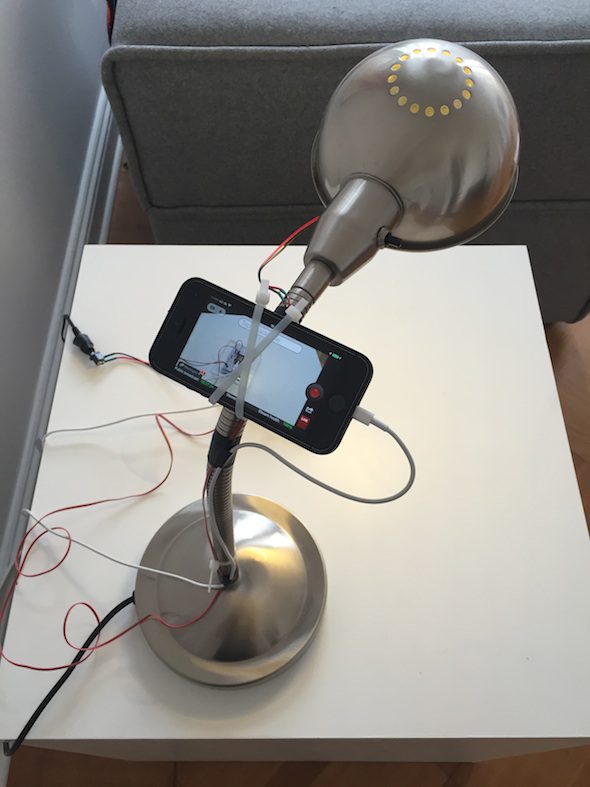
Louis-Philippe Scoufaras, Light Pressure, installation view // Courtesy the artist
Clara Meister: Carson and I met in different points in our careers through the projects and artists we worked with. I’ve been researching and working with performance for a long time. My PhD is on voice and language in art. And with my exhibition project ‘Soundfair’ we exhibited music. In both projects similar questions came up, such as: who do you listen to? Who is speaking? How do we relate to each other?
These relations kept accompanying me when Carson and I started talking about this exhibition. We are coming from different angles yet meet in our common interest in ephemeral works. When we met Nick and Hannes there were even more relationships opening up by their way of working and living: not only that they are a couple and both collectors and exhibitors, and living in this apartment.
It triggered questions about how we live with each other and how the house lives with us and vice versa? How do we live with art and how does art live with us? These different relations led us to an exhibition, which became very much about time-based works and experiences. The more we worked on it and engaged with the artists, we realized they don’t use the term performance so often but replaced the term with: choreography, scenario, intervention, exercise, experience, situation, setting, ritual… It makes us think about this idea of what a performance is and who the performer is.
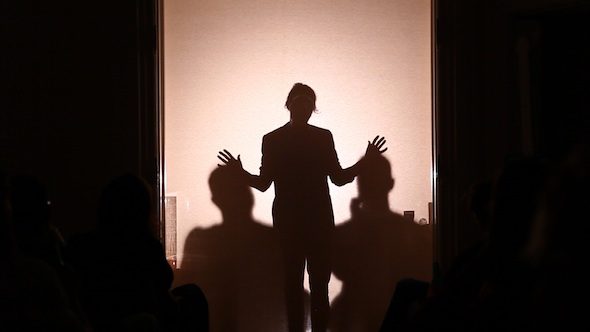
Annika Kars, the announcement, video still of the performance // Courtesy of Annika Kahrs & Produzentengalerie Hamburg
AH: Did you ask the artists to create performances specifically?
CM: Actually we asked them to create instructions.
CC: For me the term performance does not so much describe what they produce and how it is classically defined, but is rather a discursive frame through which to interrogate whatever it is that they produce. Some artists made a clear written set of instructions while others were much more loose. How do we look at any of these things as a performance? Who is the performer? Who is the audience? What is the duration? How they address or don’t address these terms is the intellectual or discursive frame of the project.
AH: When you chose the artists did you already have in mind the book as a final outcome of the work?
CM: The exhibition was always conceptualized in two stages or chapters: an exhibition in a radicalized form – with no audience, and no public exhibition space as such – and the moment when it becomes public, which is the space of the book.
CC: The book launch is also the finissage of the show. The public will have partial access to the works at the moment of the show’s closing. One thing that we wanted to do is to throw everything in question. In the end it’s much more accurately described as an experiment than an exhibition. But we made a press release, like a normal exhibition would; they put it on their website. Playing to some of the standard tropes and protocols of how exhibitions usually work allowed us to interpret it as an exhibition and to critique exhibition-making as well.
AH: In the press release, you talked about the elitism of 19th century home exhibitions. By shrinking the audience to only Nick and Hannes, are you not making it more restricted or elite?
CC: The tradition of the home as a space for the elite to show their art is what Open Forum is extending. Private collections are still happening. The main question for us is not the social worth or importance of these kinds of presentations, but how such presentations allow us to critique other traditions like performance, performer, artwork, collection, value, audience.
CM: We are rather laying bare certain structures in the art world. When we realized that Nick and Hannes were already playing so many ‘roles’ of this world we thought it was interesting to condense the exhibition format even further and make them their own audience.
What intrigues me now, in the conversations with the artists, is that it seems that there doesn’t necessarily have to be a receiver for the works. There are only two works where the artists challenged the idea that the public is excluded. Whereas I initially thought: doesn’t an art work want to communicate something to the outside world – make something visible to the ‘other’? In the end we received a lot of ‘closed circuit’ projects.
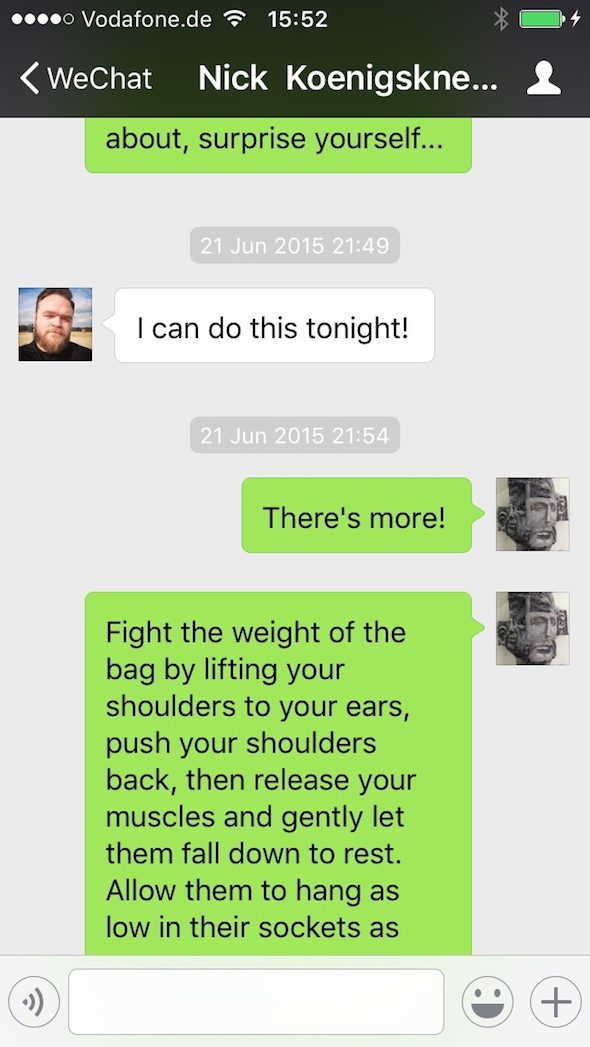
Hadley+Maxwell, There he was, gone., screenshot // Courtesy of the artists
CC: We were surprised about how unproblematic it was for the artists not to have an audience for their work. In a conversation with Hadley+Maxwell they were saying that their work included very personal text messages between them and Nick and Hannes, which a larger audience may not have access to in the future. Not having access but knowing that it happened for them constituted the work.
We asked the artists to write or produce these performances in the form of instructions for Nick and Hannes. If Nick and Hannes did not follow the instructions – if they did not produce or perform the work – then there is no show. But they would be the only ones who know that.
CM: Yet, it was always considered a work. It was never put into question whether or not Nick and Hannes executed it.
AH: Can you describe some of the pieces in the show?
CM: First, I would like to mention that we also invited artists who are not known to work with performance per se. Through this choice we hoped for situations and actual events and, with other invitations, for objects that need to be activated to challenge the notion of the performative. Fiete Stolte, for example, brought to the home a frame on a stand at eye level. He asked them – or anyone who visited the home – to just stand on either side of the frame. It has two alternating, blinking lights on the corners which give a reflection in the other person’s eyes. You meet in the other’s gaze – in the act of looking. It is so rare that you look into someone’s eyes for such a long time. There’s a lot of action going on, including the blinking lights. You get involved in the other’s eyes but you are also being looked at.
CC: I mentioned Hadley+Maxwell. One reason why we invited them is because they are an artist-couple. They work together but they have also been in a relationship for many years: they mirrored Nick and Hannes’ relationship in some ways.
We invited Tue Greenfort because his work often deals with life and biological entities. The way that Nick and Hannes lived inside the space with each other and with art fascinated us so we wanted to see how Tue could riff on this idea of ‘living with’.
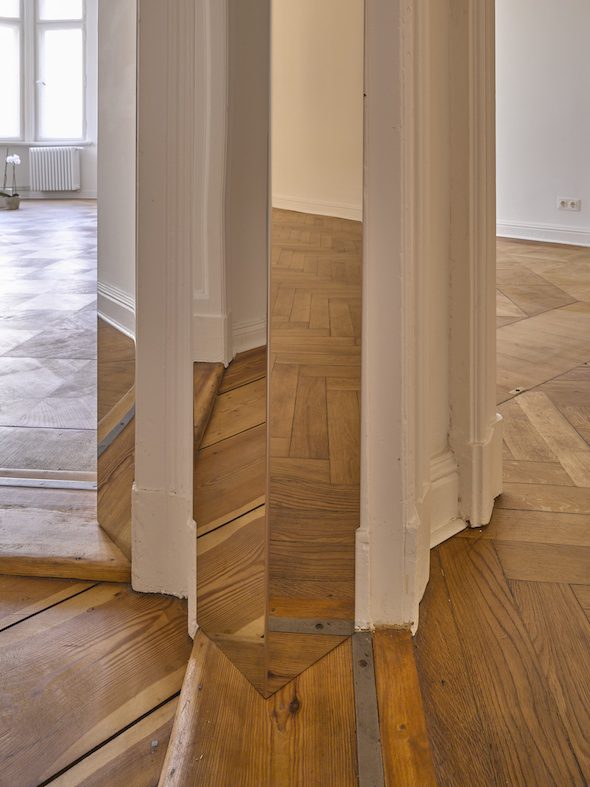
Judy Radul, Doors for a Room to Enter, installation view // Courtesy the artist
CM: Or the work of Judy Radul: she proposed an architectural intervention dealing with the idea of inside, manifest in the hallway of their apartment. She installed two mirrored objects that make the space performative, including a dead angle where there’s a moment of absence of your reflected self in the space. Part of this work is a sound piece, spoken by her, which is activated only at the moment that they leave the door. It excludes them as the audience, as well. It’s a communication between the spaces and the rooms of the apartment.
CC: This idea of negating continues with Christian Falsnaes’ work. It’s basically a contract: Nick and Hannes can call Christian at any time and when he sees their number, which is prioritized on his phone, he always has to pick up and tell them something to do. Until now, a year into the show, they have never called him. The responsibility of calling him is always at the back of their minds, just as the anticipation of being called is for Christian. Christian was telling us that when he is giving a public talk he will often open saying: “Excuse me if I have to take a call, I’m contractually obligated to answer as part of a performance.”
This work exists by the mere fact that Nick and Hannes invited us to do a show, and we invited Christian to make a work. The fact that they don’t call him and that he doesn’t tell them to do anything does not change the existence of the work. The potential of anything happening remains.
CM: Christian made himself wholly available to them and to the show, which is a big commitment. But it goes both ways: Nick and Hannes were also so open and curious to all these experiences.
Dafna Maimon requested their availability by asking them, while they were apart for a period of ten days, to send a video selfie every time they missed each other. They would send it not to each other, however, but to her. She opened up a triangular situation and became the buffer in their relationship. She turned their video selfies into a poem in transcripts, which she made into a choreography and then gave back to them. In this format they can meet again in this feeling of missing the other.
What I find compelling is that many motifs re-occurred, like the notion of absence. Or mirrors, which obviously deal with our relationship to each other and to the space. Or the idea of collecting.
CC: Going back to the concept of challenging Nick and Hannes and their institution, which is also their home and their relationship: what does it mean to want to live with art? Is collecting and living with art as simple as putting a picture on the wall or a sculpture in your living room? What if the artwork is itself an experience or a commitment. Shouldn’t artwork always be a form of commitment? What if these works asked for a certain performance or time commitment or energy from you, instead of a monetary value? These were the challenges we eagerly tried to push on them and they didn’t accept all of them.
To talk about the works that didn’t happen is as important for the show.
CM: Because it is an experiment. The idea of failure is not scary to us. There’s a chance, in the format of the book, to talk about that.
Exhibition
OPEN FORUM
Group Show: ‘Home Work’
Exhibition: Feb. 24, 2015 – Ongoing; By appointment only
Brunnenstraße 115, 13355 Berlin, click here for map
With works by: Candice Breitz, Christian Falsnaes, Jean Pascal Flavien, Tue Greenfort, Hadley+Maxwell, Christian Jankowski, Annika Kahrs, Irene Moray and Wojciech Kosma, Annika Larsson, Lindsay Lawson, Dafna Maimon, Niko Princen, Judy Radul, Yorgos Sapountzis, Louis-Philippe Scoufaras, Fiete Stolte, and Anna Witt
Writer Info
Alison Hugill has a Master’s in Art Theory from Goldsmiths College (2011). Her research focuses on marxist-feminist politics and aesthetic theories of community, communication and communism. Alison is an editor, writer and curator based in Berlin. www.alisonhugill.com
This article is part of our BLINK series, which introduces the practices of artists around the world. To read more BLINK articles, click here.




















